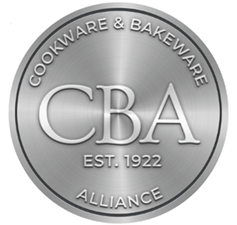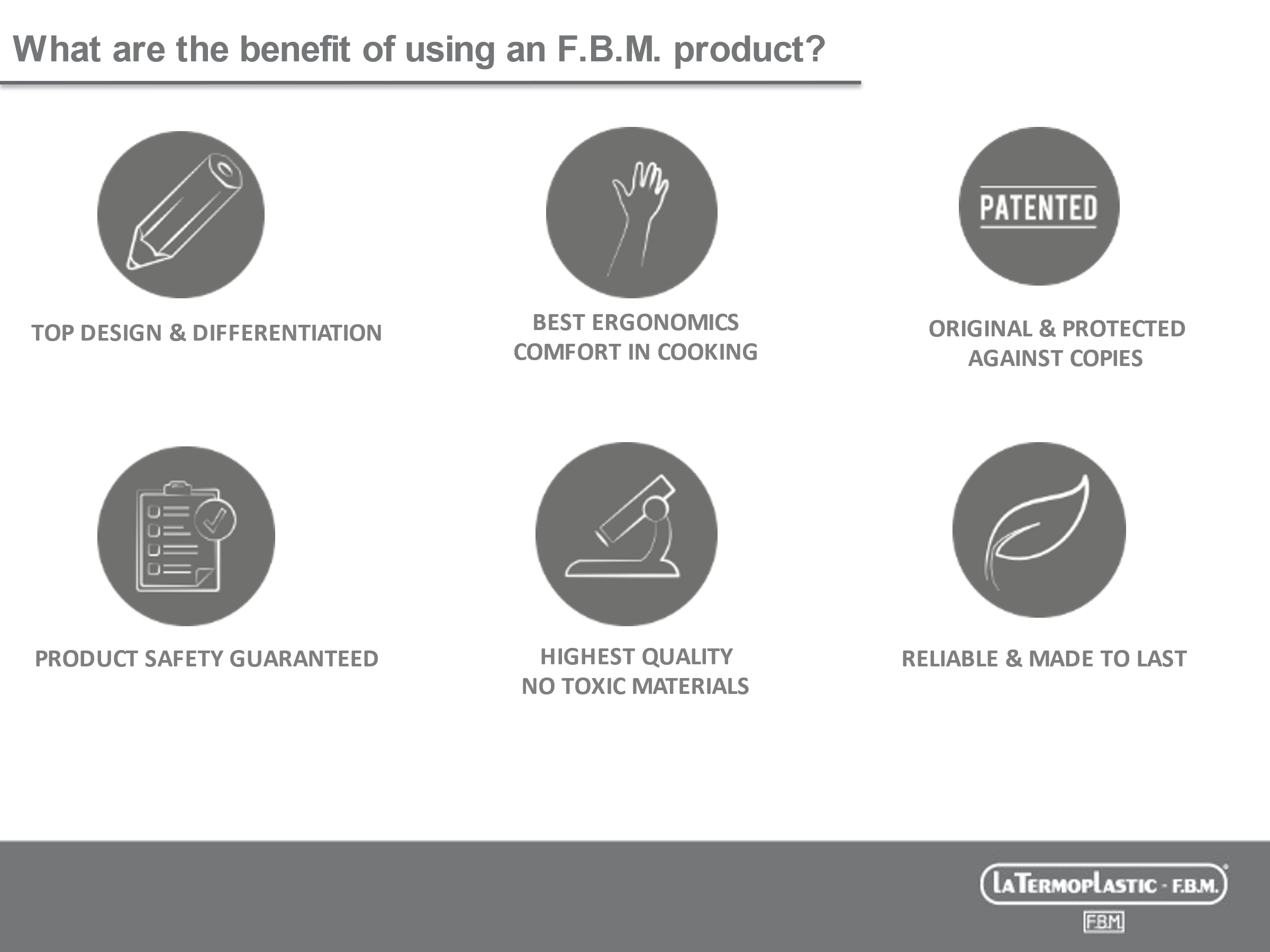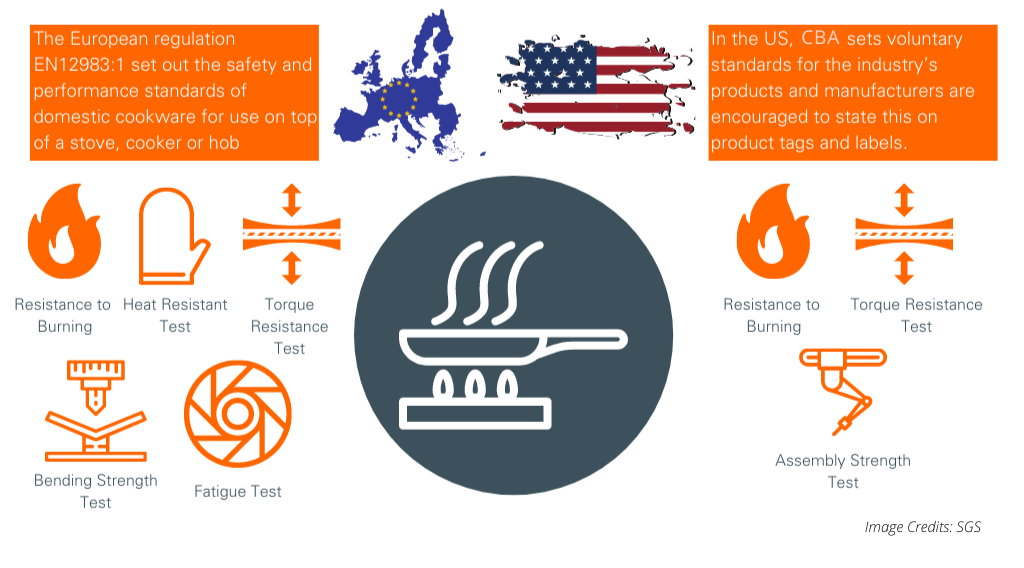Cookware standards exist to create a baseline quality measurement in the market. Manufacturers, brands, retailers and consumers know when they buy a product that is compliant with European regulations or US standards, they are getting quality pots and pans that have been thoroughly tested for domestic use. These standards are related, but not identical, on either side of the Atlantic.
Have you ever wondered how pots and pans are tested for domestic use? What are the advantages of purchasing products that comply with European regulations or US standards?
Read on to find out how to assess safety in cookware.
EUROPEAN STANDARDS FOR COOKWARE PRODUCTS
The main European standards for cookware is the EN12983, which set out the safety and performance of domestic cookware for use on top of a stove, cooker or hob.
The EN 12983:2023 has been lastly updated and released in 2023 and it introduces significant changes to the construction and performance requirements for household goods. Understanding these changes, as well as the tests involved, is crucial for manufacturers and retailers to ensure compliance, maintain product quality, and meet consumer expectations.
Here a summary of most crucial tests regarding handles for cookware in this EU standards:
- Resistance to Burning: this test is performed to ensure that if a cookware handle is accidentally exposed to a direct flame source, it won't melt, lose pieces and put the user or the surface at risk of burns or surface damage.
- Heat Resistance Test: this test is performed to ensure that the cookware handle doesn't crack or break under exposure to prolonged heat by inserting the handle into the oven.
- Torque Resistance Test: the test involves the application of a torsion force on both sides of the handle, tightening the axis to ensure rotations don't damage the fastening system.
- Bending Strength Test: this test exposes the cookware handle to a force gradually released on the posterior part of the handle. The test stresses the resistance of the fixing system and the handle to ensure the user's safety.

- Fatigue Test: in this test the pot is filled in with an extra load and undergoes 15,000 cycles of up and down. The test wants to ensure that the cookware handle and its fixing system won’t have any permanent distortion or loosening since it stresses the cookware by overloading it with much more weight that what will be used in normal domestic cooking.
- Pull of Handle Assembly: the test is for assembled handles, which are pulled using a weight and must withstand a further dynamic impact without any damage.
These standards introduce significant changes to construction and performance requirements, emphasizing safety and durability.
Staying informed about the latest updates in European cookware standards is paramount for manufacturers and retailers alike.
US STANDARDS FOR POTS AND PANS
In the U.S.A., The Cookware and Bakeware Alliance (CBA), is a trade organization that sets voluntary standards for the industry’s products. Companies who adhere to CMA standards are encouraged to state this fact in advertising and promotional materials, as well as on product tags and labels.
The list of tests required by the CBA Engineering Standards has been recently updated too, with important revisions and a further harmonization with respect with the European ones.
The standard also includes a specific section dedicated to Handles & Fitting with tests focusing on handle assembly, how to measure handles and knob temperature and a specific guide for plastic cookware handle.
Among the tests included in the Engineering Standards Assembly Strength Test is particularly challenging in its HOT procedure since it requires the cookware to be loaded and to resist in a heated oven at 350 °F. This challenging test puts stress on the mechanical properties of the pot during weightlifting phase. It can be considered the test that determines the main difference between the two regulations.
F.B.M. YOUR COOKWARE HANDLE PARTNER FOR QUALITY AND SAFETY
A thorough understanding of the physical and mechanical qualities of your cookware is vital if you want to demonstrate the safety, quality and durability of your products to your customers.
The handle is the only element the cooker interacts with when cooking and the feeling of safety and quality that the user get is very important. This is true both at the point of purchase (crucial for buying decision making) and every day at home.
F.B.M. as a Global manufacturer of high-quality cookware handles and pans have established a reputation for unique design, innovation and certified quality in all the products we carry.

Furthermore, F.B.M. actively participates in leading international cookware associations such as CBA in the United States and FEC in Europe, collaborating extensively on PFAS-related issues, Sustainability and other regulations. In line with our unwavering commitment to quality and safety, F.B.M. conducts ongoing research and analysis of our products.
.png?width=285&height=276&name=Pasqua%20solidale%202024%20(1).png)

If you want to know more and have key details about the main international standards and F.B.M. tests, just download the free white paper.



-Apr-03-2024-08-08-21-8075-AM.png?width=750&height=600&name=Image%20Credits%20SGS%20(1)-Apr-03-2024-08-08-21-8075-AM.png)

